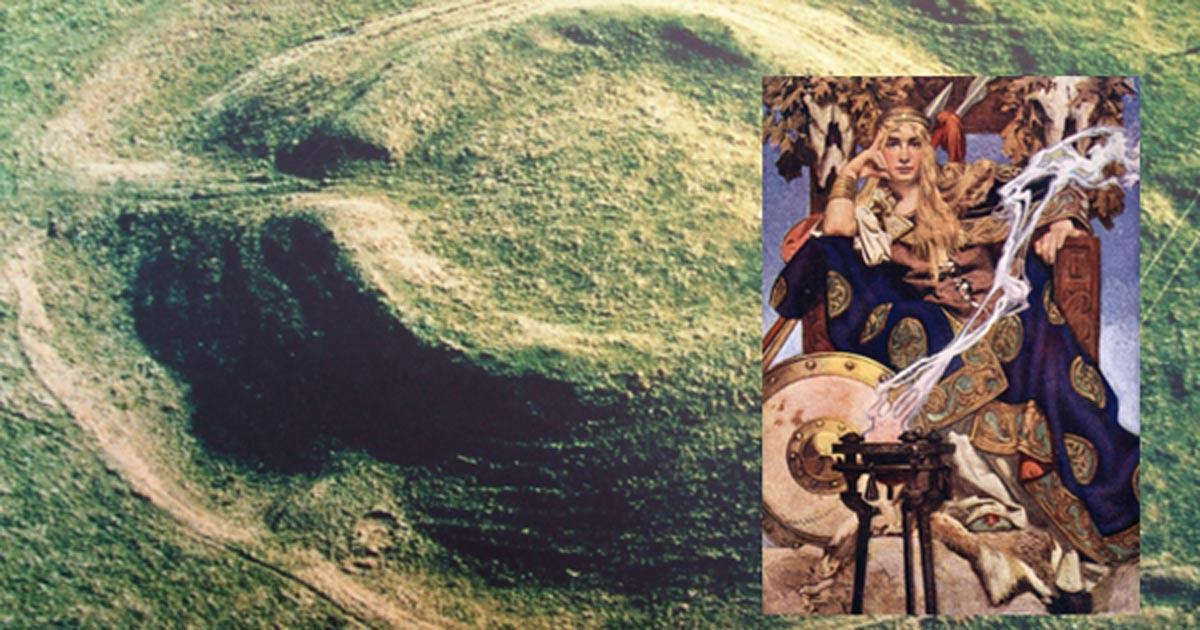
Rathcroghan, Home of the Prehistoric Rulers of Connacht in Irish Mythology
Rathcroghan, which is said to mean Fort of Cruachan, is a complex of archaeological sites containing about 60 different national monuments. These include barrows, a holy well, standing stones and a supposedly haunted cave. It has been pointed out that this complex is spread out over several townlands (a geographical division of land used in Ireland) around the village of Tulsk in County Roscommon, Ireland. Rathcroghan has been regarded as an important site in the history and mythology of Ireland.
Rathcroghan has been identified by some as the site of Cruachan, the traditional capital of the Connachta (aloso Connacht, Connaught), home of the prehistoric and early historic rulers of the western territory. According to one source, Cruachan is derived from the name of goddess Crochen, whose name meant ‘drinking vessel’ or ‘cup’. Cruachan is believed to have been her magical cauldron, where she gave birth to Medb (meaning ‘Intoxicating One’), a queen of Connacht in the Ulster Cycle of Irish mythology.

Queen Medb of Connacht by J. C. Leyendecker (public domain)
Rathcroghan’s association with the kings of Connacht, who are said to have reigned during the Middle Ages, meant that it has been considered as a royal site. According to tradition, it was at Cruachan that the inauguration ceremonies of the kings of Connacht were performed. The occupation of Rathcroghan, however, stretches further back in time, as one may gather by examining the archaeological evidence.

A carving of Cathal, who is often regarded as the last ‘great’ king of Connacht (monastic.ie).
One of the most recognisable monuments in Rathcroghan, for example, is the Rathcroghan Mound, which is said to be the largest and most accessible monument in the complex. The Rathcroghan Mound has been dated to the Iron Age, and it has been suggested that it was used for ceremonial purposes. Although this ancient structure has not been excavated, magnetic gradiometry has allowed archaeologists to have a look at what lies within it. The image produced by these surveys show that there are pits and ditches, which may have served as palisade trenches. Other features picked out from the imaging include a trapezoid leading to the mound of the east, which has been interpreted as a ceremonial avenue, as well as a double circle of pits, which may indicate that a large wooden structure once stood on top of the mound. Based on such clues, some have suggested that Rathcroghan Mound was once topped by wooden ramparts and ceremonial henges.

A view of the Rathcroghan Mound. Photo source: Wikimedia.
As mentioned earlier, one of the mythical figures closely linked to Rathcroghan is Medb, the daughter of the goddess Crochen. According to legend, Medb was the wife of Ailill, a king of Connacht, and it was from Rathcroghan that the royal couple ruled over their lands. Medb appears in a number of Irish legends, one of which being Táin Bó Cúailnge, which translates as The Cattle Raid of Cooley.
In this epic, Medb plays the role of an antagonist in opposition to the famous hero Cúchulainn. In the tale, Medb and her husband got into an argument, which resulted in the queen’s bid to obtain Donn Cuailgne, the Brown Bull of Cooley, which belonged to Dáire mac Fiachna. Medb brought her army to Ulster in order to seize the bull. Although the hero Cúchulainn fought to defend the bull from being captured by the queen, Medb eventually succeeded in stealing it from Dáire, and brought it back to Rathcroghan.

A statue of Queen Medb holding the head of a bull, seen in Beresford Place, Dublin, created by artist Patrick O'Reilly.
The connection between Medb and Rathcroghan can also be seen in several other monuments in Rathcroghan. There is, for instance, the Miscaun Medb (translated as the ‘lump (of rock) of Medb, and known locally as ‘Medb’s Butter’). This is a fallen 2.9 m sandstone slab located to the northwest of the Rathcroghan Mound which is believed to mark the grave of Medb. There is another stone known as Milleen Medb (translated as the ‘small lump (of rock) of Medb, and known locally as ‘Medb’s Cheese’). This stone, together with the Miscaun Medb, is said to form an entrance avenue to Rathcroghan, and through which all future rulers of Connacht entering the royal site were required to pass.
Top image: The Rathcroghan mound (rathcroghan.ie)
By Wu Mingren
References
Lonely Planet, 2016. Rathcroghan. [Online]
Available at: http://www.lonelyplanet.com/ireland/strokestown-around/sights/historic/rathcroghan
Megalithic Ireland, 2016. Ráth Cruachan. [Online]
Available at: http://www.megalithicireland.com/Rath%20Cruachan%20Rathcroghan.html
Rathcroghan Visitor Centre, 2016. Rathcroghan. [Online]
Available at: http://www.rathcroghan.ie/
Sacred Site Tours, 2016. Rathcroghan Royal Site. [Online]
Available at: http://sacredsitetour.com/rathcroghan-royal-site-sacredsites-ireland
Voices from the Dawn, 2016. Rathcroghan Royal Site. [Online]
Available at: http://www.voicesfromthedawn.com/rathcroghan/















